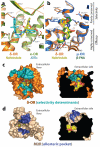Structure of the δ-opioid receptor bound to naltrindole
- PMID: 22596164
- PMCID: PMC3523198
- DOI: 10.1038/nature11111
Structure of the δ-opioid receptor bound to naltrindole
Abstract
The opioid receptor family comprises three members, the µ-, δ- and κ-opioid receptors, which respond to classical opioid alkaloids such as morphine and heroin as well as to endogenous peptide ligands like endorphins. They belong to the G-protein-coupled receptor (GPCR) superfamily, and are excellent therapeutic targets for pain control. The δ-opioid receptor (δ-OR) has a role in analgesia, as well as in other neurological functions that remain poorly understood. The structures of the µ-OR and κ-OR have recently been solved. Here we report the crystal structure of the mouse δ-OR, bound to the subtype-selective antagonist naltrindole. Together with the structures of the µ-OR and κ-OR, the δ-OR structure provides insights into conserved elements of opioid ligand recognition while also revealing structural features associated with ligand-subtype selectivity. The binding pocket of opioid receptors can be divided into two distinct regions. Whereas the lower part of this pocket is highly conserved among opioid receptors, the upper part contains divergent residues that confer subtype selectivity. This provides a structural explanation and validation for the 'message-address' model of opioid receptor pharmacology, in which distinct 'message' (efficacy) and 'address' (selectivity) determinants are contained within a single ligand. Comparison of the address region of the δ-OR with other GPCRs reveals that this structural organization may be a more general phenomenon, extending to other GPCR families as well.
Figures




Comment in
-
Structural biology: How opioid drugs bind to receptors.Nature. 2012 May 16;485(7398):314-7. doi: 10.1038/485314a. Nature. 2012. PMID: 22596150 Free PMC article.
References
-
- Lipkowski AW, Tam SW, Portoghese PS. Peptides as receptor selectivity modulators of opiate pharmacophores. J Med Chem. 1986;29:1222–1225. - PubMed
Publication types
MeSH terms
Substances
Associated data
- Actions
Grants and funding
LinkOut - more resources
Full Text Sources
Other Literature Sources
Molecular Biology Databases

